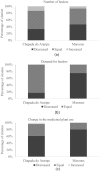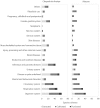The coexistence of traditional medicine and biomedicine: A study with local health experts in two Brazilian regions
- PMID: 28414735
- PMCID: PMC5393556
- DOI: 10.1371/journal.pone.0174731
The coexistence of traditional medicine and biomedicine: A study with local health experts in two Brazilian regions
Abstract
This study investigated the combined use of traditional medicine and biomedicine by local experts in Chapada do Araripe communities (Ceará State) and maroon communities (Santa Catarina State), Brazil. The objective was to understand the perception of local health specialists regarding the number of healers, demand for healers and use of medicinal plants, and the dependence of different environments to obtain such plants. We also aimed to understand the role of medicinal plants to treat different categories of diseases and if there is a complementary use of medicinal plants and allopathic biomedicine, according to the context of each group. The research was conducted with local health specialists that answered structured interviews, created free lists and participated in guided tours to collect cited plants. Sixty-six local health specialists were identified in the Araripe communities and 22 specialists in the maroon communities. In the maroon communities, a greater number of specialists thought there was a decrease in the number and demand for healers, as well as the use of medicinal plants, due to changes in traditional livelihoods, since they are located in a region where the effects of the modernization were more intense. In the Chapada do Araripe communities the specialists knew more plants extracted from native vegetation, whereas in the maroon communities cultivated plants were better known, which may reflect the environmental conditions and the history of each region. Medicinal plants are preferred to treat simpler health problems that do not require medical care, such as gastrointestinal problems, general pain, flues and colds. The biomedicine is used principally for problems with blood pressure, general pains and endocrine and nutritional diseases. Even with the particularities of each region, in general the use of medicinal plants and biomedicines occurred in a complementary form in both regions; however, this coexistence may result from these different contexts. This study also found that there was knowledge and appreciation for traditional health practices in both regions.
Conflict of interest statement
Figures



Similar articles
-
Ethnomedicinal survey of a maroon community in Brazil's Atlantic tropical forest.J Ethnopharmacol. 2016 Apr 2;181:37-49. doi: 10.1016/j.jep.2016.01.014. Epub 2016 Jan 21. J Ethnopharmacol. 2016. PMID: 26802786
-
Do ferns and lycophytes function as medicinal plants? A study of their low representation in traditional pharmacopoeias.J Ethnopharmacol. 2015 Dec 4;175:39-47. doi: 10.1016/j.jep.2015.09.003. Epub 2015 Sep 10. J Ethnopharmacol. 2015. PMID: 26363238
-
Ethnobotanical study of plants used for therapeutic purposes in the Atlantic Forest region, Southern Brazil.J Ethnopharmacol. 2015 Apr 22;164:136-46. doi: 10.1016/j.jep.2015.02.005. Epub 2015 Feb 11. J Ethnopharmacol. 2015. PMID: 25680844
-
Historical versus contemporary medicinal plant uses in the US Virgin Islands.J Ethnopharmacol. 2016 Nov 4;192:74-89. doi: 10.1016/j.jep.2016.07.005. Epub 2016 Jul 1. J Ethnopharmacol. 2016. PMID: 27377341 Review.
-
Intercultural health and ethnobotany: how to improve healthcare for underserved and minority communities?J Ethnopharmacol. 2013 Jul 30;148(3):746-54. doi: 10.1016/j.jep.2013.05.039. Epub 2013 May 31. J Ethnopharmacol. 2013. PMID: 23727048 Review.
Cited by
-
Factors affecting local plant knowledge in isolated communities from Patagonian steppe: Metacommunity theory is revealed as a methodological approach.PLoS One. 2022 Sep 12;17(9):e0274481. doi: 10.1371/journal.pone.0274481. eCollection 2022. PLoS One. 2022. PMID: 36094933 Free PMC article.
-
Do socioeconomic factors and local human preference determine the hybridization of knowledge in local medical systems?J Ethnobiol Ethnomed. 2024 Aug 17;20(1):76. doi: 10.1186/s13002-024-00722-8. J Ethnobiol Ethnomed. 2024. PMID: 39154031 Free PMC article.
-
The influence of urbanization on local ecological knowledge: a systematic review.J Ethnobiol Ethnomed. 2024 Dec 18;20(1):106. doi: 10.1186/s13002-024-00747-z. J Ethnobiol Ethnomed. 2024. PMID: 39695704 Free PMC article.
-
Notes on current Mbyá-Guarani medicinal plant exchanges in southern Brazil.J Ethnobiol Ethnomed. 2021 Jun 2;17(1):38. doi: 10.1186/s13002-021-00465-w. J Ethnobiol Ethnomed. 2021. PMID: 34078398 Free PMC article.
-
An exploration of barriers and enablers to the conduct and application of research among complementary and alternative medicine stakeholders in Australia and New Zealand: A qualitative descriptive study.PLoS One. 2022 Feb 18;17(2):e0264221. doi: 10.1371/journal.pone.0264221. eCollection 2022. PLoS One. 2022. PMID: 35180276 Free PMC article.
References
-
- WHO. Traditional medicine Fact sheet N134. Geneva: WHO; 2008. http://www.who.int/mediacentre/factsheets/fs134/en/print.html. Accessed 16 June 2015.
-
- Oliveira ECS, Trovão DMBM, 2009. O uso de plantas em rituais de rezas e benzeduras: um olhar sobre esta prática no estado da Paraíba. Revista Brasileira de Biociências. 2009; 7(3), 245–251.
-
- Da Silva GS. Benzedores e raizeiros: saberes partilhados na comunidade remanescente de quilombo de Santana da Caatinga. Revista Mosaico. 2010; 3(1),33–48.
-
- Boing L, Stancik MA. Benzedeiras e benzimentos: práticas e representações no município de Ivaiporã/PR (1990–2011). Ateliê de História UEPG. 2013; 1(1), 85–96.
-
- Amorozo MCM. Pluralisticmedical settings and medicinal plant use in rural communities, Mato Grosso, Brazil. Journal of Ethnobiology. 2004; 24 (1), 139–161.
MeSH terms
LinkOut - more resources
Full Text Sources
Other Literature Sources

